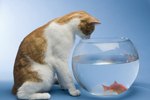Potbelly mollies, also commonly known as balloon mollies, are a domesticated variety of Poecilia latipinna, the sailfin molly. Their unusual shape is not seen in the wild. As with other highly inbred fish varieties, specimens of this variety don’t grow as fast or live as long as naturally occurring mollies. Breeding potbelly mollies is discouraged. Their care is fairly straightforward.
Step 1
Establish a tropical tank with plenty of aquatic plants. Mollies can tolerate a range of salinities. A saltwater tank is difficult to maintain, but mollies are prone to disease in a completely freshwater tank; the best option is a slightly brackish one – i.e. freshwater with a little salt mix added. Use about 1 teaspoon of salt mix per gallon of water. Note that larger tanks are easier to maintain than smaller ones.
Step 2
Maintain a habitat temperature of a about 75 to 82 degrees Fahrenheit, adjusting the thermostat as required.
Step 3
Introduce mollies to the habitat one or two at a time over a period of several weeks to allow the tank ecosystem to adjust. Because this is a social species, mollies are best kept in small groups. They are compatible with other peaceful species, such as platies. Do not overstock the tank. At maximum, have 1 inch of fish per gallon of water, based on the largest of the adult fish, not the length of juveniles or smaller adults. Smaller than some sailfins, potbelly mollies reach up to 3 inches long, meaning a 20-gallon tank can house only about six individuals.
Step 4
Feed mollies frequently – two or three times a day. A flake food for algae eaters in general or mollies in particular is a suitable basic food; a few times a week supplement with live food such as daphnia and vegetables such as finely shredded lettuce or boiled peas. Give the fish as much as they can eat within a couple of minutes. Remove leftovers.
Step 5
Conduct partial water changes once a week. Remove about a quarter of the water using a gravel cleaner and bucket, siphoning waste as you do so. Replace with fresh dechlorinated water that already has the appropriate amount of salt added.
References
Tips
- Although sociable, mollies of all types can be competitive. The most stable social group for a home aquarium is probably one male and a few females. They may breed, but it is unlikely that more than a few fry -- babies -- will survive to adulthood in a community tank, since adult fish will eat them. Provided you have not overstocked, the survivors shouldn’t need a new tank. If you are concerned about inbreeding, select a male from a different variety of sailfin molly.
Warnings
- If your tank is a brackish one, don’t introduce other species unless they too can tolerate some salinity. Many species of aquarium fish can tolerate only completely fresh water or water with full seawater-strength salinity.
Writer Bio
Judith Willson has been writing since 2009, specializing in environmental and scientific topics. She has written content for school websites and worked for a Glasgow newspaper. Willson has a Master of Arts in English from the University of Aberdeen, Scotland.





